Mumbai: Dharavi is Asia’s largest slum with a population of about 1,000,000 people spread on an area of approximately 2.1 square kilometers.
Since April, the health authorities visited 47,500 houses and examined about 700,000 people to measure their temperatures and oxygen levels. Fever clinics were set up, schools and sports clubs converted in to quarantine centers. Those showing Covid-19 symptoms were shifted there. Per day infection rate has dropped down to one third compared to early May. More than half the patients are recovered, and the number of deaths have been reduced.
On the other hand, in other places of India, where the daily count of new infected cases has quadrupled since early May. Dharavi’s committed approach to fight the virus has become a model for other slums of Asia, Africa and Latin America. In spite of slum’s huge population Dharvi successfully fought the coronavirus successfully.
“It was next to impossible to follow social distancing, the only option then was to chase the virus rather than wait for the cases to come. To work proactively, rather than reactively” The Economic Times quoted Kiran Dighavkar, assistant commissioner at Mumbai’s municipality, who is in charge of leading the fight in Dharavi as saying.

In the beginning, the officials were worried because of the increasing positive cases. But, Dighavkar and his team decided to continue the screenings and tests. Their aim was to limit the deaths.
“We were able to isolate people at early stages,” Dighavkar said. “Unlike in the rest of Mumbai, where most patients are reaching hospitals at a very late stage.”
This strategy has helped reduce mortality and improve recovery. About 51% of Dharavi residents who test positive eventually recovered, better than Mumbai’s 41% rate. Fresh infections are down to an average 20 a day from 60 in early May.
All this was possible because of Dharavi’s cooperation, strict lockdown, testing and quarantine facilities availability of doctors on location to take care of the patients.
In Ramadan, those who were in the isolation centers were provided with proper food and fruits so that they can conveniently carry on their formalities of fasting. while all others received three meals a day.
Free Services
Even during these hard times, Dighavkar and his team is providing 24 hours medical service free of cost to the patients when millions of people lost their jobs and people have died before they were allotted hospital beds.
Dharvis became so conscious that they wanted to be quarantined as soon as symptoms appeared, said Dighavkar. He further added, there should no pressure to keep number of cases low, focus is needed on screening and timely treatment, because the ultimate aim is to save lives.
“The battle can’t be over until the virus has gone from the entire city, state and country,” said Dighavkar. “People are quite aware now of how to be safe and I think by the time the lockdown ends, most of us may have got herd immunity. Or so we hope.”



